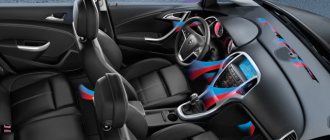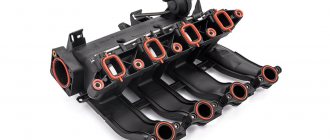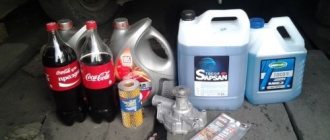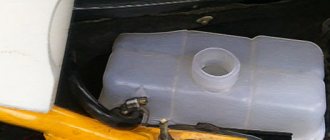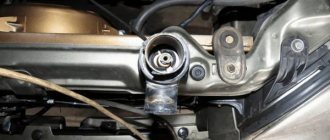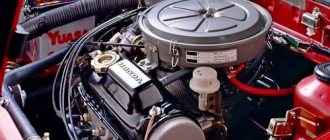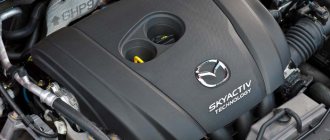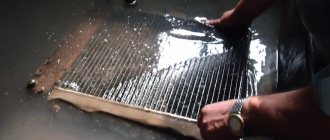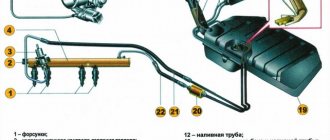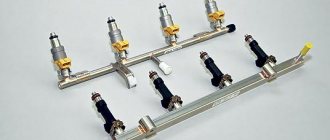Short description
The Toyota 1JZ-GE engine was installed on Toyota Crown, Toyota Chaser, Toyota Cresta and Mark 2 (JZX81, JZX90, JZX100, JZX110) cars. Peculiarities. The JZ series are six-cylinder in-line engines ranging from 2.5 to 3 liters. This series replaced the M series in 1990. The 1JZ-GE engine was produced from 1990 to 2007. There are two versions of this engine, with and without VVT-i (until 1996). The characteristics of the engine without VVT-i are a little more modest - power is 180 hp. and a torque of 235 N•m. Characteristics with a variable valve timing system are provided in the table below. The 1JZ-GE engine has a timing belt drive, a two-stage intake manifold, i.e. with variable geometry. Until 1996, the ignition system was installed contactless (distributor); since 1996, the DIS-3 electronic ignition system was installed. Disadvantages and malfunctions: the presence of a long oil receiver, which slows down the oil supply after starting the engine; the entire oil system is sensitive to the quality and condition of the engine oil; the engine is afraid of humidity (engine pressure washing); throttle module, which limits access to the middle spark plugs. The service life of the Toyota 1JZ-GE engine is about 300 thousand km.
Review of faults and methods for repairing them
Personal experience of Toyota C-HR
The 1GZ-FE engine took over all the “sores” from the 1JZ-GE. The power plant turned out to be very reliable, but it is not protected from design flaws.
Below are the most typical breakdowns and weak points:
- With high mileage, oil consumption is often observed, since the engine has a large volume, oil consumption can reach 2 liters per 1000 km. The problem can most often be solved by simply replacing the oil seals. If replacing the oil deflectors does not bring results, then only a major engine overhaul will help.
- A knocking sound in the cylinder head area is almost always caused by incorrect valve clearance. Adjustment helps to cure this malfunction. Repair consists of installing thermal clearances specified by the manufacturer. Also, rattling in the heads can be caused by wear of the camshaft/pastel friction pair. In this case, grinding of the camshafts and a complete repair of the cylinder head are required.
- Strong vibrations can be caused by a significant difference in compression in the cylinders, this is observed when the valves are clamped or when the CPG is worn.
- During a standing start, failures in engine operation are often observed. Resetting the ECU helps.
- Incorrect engine operation may be caused by a lack of fuel pressure. Clogged fuel filters are to blame. Cars equipped with this engine should only be filled with high-quality fuel.
- VVT-I valves fail at high mileage and cannot be repaired; only replacement will help. Violation of oil change intervals can affect the entire variable valve timing system - oil deposits can clog clutches and valves. If this happens, the VVT-I elements should be washed.
- Problems with idle speed are caused by contamination of the IRR valve; cleaning and adapting the unit will help cure the problem.
Engine characteristics of Toyota 1JZ-GE Mark 2, Crown, Chayzer, Cross
| Parameter | Meaning |
| Configuration | L |
| Number of cylinders | 6 |
| Volume, l | 2,491 |
| Cylinder diameter, mm | 86,0 |
| Piston stroke, mm | 71,5 |
| Compression ratio | 10,5 |
| Number of valves per cylinder | 4 (2-inlet; 2-outlet) |
| Gas distribution mechanism | DOHC |
| Cylinder operating order | 1-5-3-6-2-4 |
| Rated engine power / at engine speed | 147 kW - (200 hp) / 6000 rpm |
| Maximum torque/at engine speed | 255 N•m / 4000 rpm |
| Supply system | Multiport injection with EFI electronic control |
| Recommended minimum octane number of gasoline | 95 |
| Environmental standards | — |
| Weight, kg | 200 |
Motor specifications
Summary table of technical characteristics of the 1JZ-GE engine
| Engine capacity | 2.5 l. |
| Power indicator | From 180 to 200 hp |
| Cylinder radius | 43 |
| Additional information about the motor | 3 |
| Fuel fluid type | Gasoline fuel with 98 octane number |
| Maximum power parameters | 180 hp (132kW) / 6 thousand rpm. 180 hp (132 kW) / 6.2 thousand rpm. 196 hp (144 kW) / 6 thousand rpm. 200 hp (147 kW) / 6 thousand rpm. |
| Maximum torque parameters | 235 Nm (24 kg*m) / 4.8 thousand rpm 250 Nm (26 kg*m) / 4 thousand rpm 255 Nm (26 kg*m) / 4 thousand rpm |
| The presence of a mechanism for changing the volume of cylinders | absent |
| Minimum and maximum fuel consumption values | 5.9 and 16.7 liters per 100 km. |
| Availability of a start-stop system | absent |
| Compression levels | From 9 to 11 |
| Type of motor installation | 6-cylinder, 24-valve, DOHC, liquid cooled |
| Piston stroke | 72 mm |
Service
Changing the oil in the Toyota 1JZ-GE engine. On Toyota Crown, Chaser, Cresta and Mark 2 cars with a 1JZ-GE engine, the engine oil is changed every 10 thousand kilometers. Pour oil into the engine: when replacing the oil filter, pour 4.5 liters; without changing the filter, pour 4.2 liters of engine oil. What kind of oil to pour into the engine - according to the API classification, for early models it is not lower than SG, for later models it is not lower than SJ. Recommended SAE oil viscosity is 5W-30 and 10W-30. When operating under severe conditions, it is recommended to change the engine oil and filter twice as often. The timing belt is replaced every 100 thousand kilometers. If the timing belt breaks, the valve does not bend. The air filter will need to be replaced after 40 thousand km of service. At this mileage, it is necessary to replace the fuel filter and coolant in the cooling system. The filling capacity of the cooling system for 2WD vehicles is 7 liters, for 4WD vehicles – 7.6 liters. Spark plugs are replaced depending on their type. Conventional once every 20,000 km, iridium once every 100,000 km. Spark plugs for Toyota 1JZ-GE engine – Denso PK16R11, NGK BKR5EP11. Every 20 thousand km it is necessary to check the valve clearances.
All 1G
very reliable in operation.
The advantages of these engines include: very low noise and vibration during operation, long service life (although this does not apply to turbocharging (1G-GTE
).
The disadvantages of these engines include increased sensitivity to the quality of engine oil. Among the characteristic defects was the oil pressure sensor on 1G-FE
(especially 88 - 98 years of production), i.e.
when everything is in order with the lubrication system, and the sensor lamp is constantly on when the engine is running, which is why many owners of cars with 1G-FE
were seriously scared, counting on the upcoming serious repair.
These engines have no other weak points. _________________________________________ Inline six-cylinder engine with a volume of two liters, with a cylinder firing order of 1-5-3-6-2-4
.
This engine was installed on various versions of Toyota Mark-2, Toyota Chaser, Toyota Cresta, Toyota Crown, Toyota Soarer and Toyota Supra, Toyota Altezza, Toyota Verossa
, and on
Toyota Mark-2 Blit
right up to 2007.
It is easy to operate and replacing engine components does not require much difficulty. It is equipped with hydraulic valve lash compensators. Its advantage is low noise, its disadvantages are that it is critical to the condition of the camshaft and the quality of the oil, and also if the timing belt breaks, the valves meet the pistons. These engines are very reliable with proper care. _________________________________________ I personally know a person whose 1G BEAMS
(which everyone hates) lasted 570 thousand km without major repairs. The main thing is to try to find a motor that is not dead and regularly service it with high-quality oil, but also not to damage it naturally (this motor is not for racing, but for a quiet, comfortable ride).
Read more: Tuning Niva rear suspension
series engines are a Japanese LEGEND,
they began to be installed in 1992 on cars of the
Toyota Mark 2, Toyota Cresta, Toyota Chaser, Toyota Crown, Toyota Aristo brands
.
This is a six-cylinder engine with a volume of 2.5 liters
.
2JZ-GE
engine has a volume of
3 liters
and is installed on
the Toyota Supra and Toyota Soarer
, it also has a twin 2JZ-GTE turbocharged modification.
__________________________________________ 1JZ-GE - volume 2491 cc.
cm., 2JZ-GE - volume 2997 cc. cm. ( they differ only in the stroke of the piston).
Six-cylinder naturally aspirated in-line engines, two camshafts, both camshafts are driven by a belt (if the belt breaks, the valves do not meet the pistons). 24 valves (4 valves per cylinder: two intake and two exhaust). The modern version (since August 1998) is equipped with VVT-i
(variable valve timing, externally can be identified by the presence of a characteristic “growth” in the front part of the engine on the axis of the left camshaft).
Power 1JZ-GE - about 180 hp.
torque about 25 kilogram-meters
(with VVTi about 200 hp), 2JZ-GE about 220 hp.
and 30 kilogram meters.
There is some difference in the characteristics of the engines given for different cars, this is probably due to the slightly different design of the engines on different bodies. For example, there are at least two types of air filters and intake pipes for the 1JZ-GE.
(on ARISTO 2JZ-GE with a power of 230 hp, on CROWN, CHASER, MARK II, CRESTA with a power of 220 hp) Installed on rear- and all-wheel drive Toyota models:
crown (1JZ-GE, 2JZ-GE), crown Majesta (2JZ-GE), Mark II family (1JZ-GE, 2JZ-GE, 1JZ-GTE), Aristo, Lexus GS300 (1JZ-GE?, 2JZ-GE), Soarer, Lexus SC 300 (2JZ-GE, 1JZ -GTE), supra (2JZ-GTE).
There are no hydraulic valve lash compensators, the valves can be adjusted (adjusted with washers), they say it makes sense only during major repairs.
Compression ratio 10.0 (10.5 from some sources)
.
Drives without problems on 92-gasoline;
on the 95th, and especially on the 98th , as a rule, it starts worse, but supposedly drives faster.
There are two knock sensors. The ignition system is electronic, with a distributor; the ignition coil is located separately from the distributor. Since 1996,
the ignition system has been modernized and does not have a distributor; there is one ignition coil for every 2 spark plugs.
Platinum spark plugs, change after 100,000 km. Multi-point injection, ordinary. The crankshaft position sensor is located inside the distributor. There is no starting injector. The idle air control valve opens a separate channel in the throttle body. Vacuum air flow meter. Oil volume is about 5 liters. The coolant volume is about 8 liters. The radiator is cooled by a fan mounted on the water pump shaft through a viscous coupling. The fan is 7-blade, exactly the same as on the 2JZ-GE. There are also, depending on the model of the machine, one or two small electric fans that turn on when the air conditioner or the corresponding sensors are turned on. Cooling system with atmospheric reservoir and valve on the radiator. The lambda probe (oxygen sensor) is installed quite close to the exhaust manifold, easily accessible from the engine compartment; depending on the version with or without heating (2 or 4 wires), and without heating on older models (before 1992) and on 2JZ-GE
.
____________________________________________ Disadvantages:
1. There is only one drive belt for the units (water pump, power steering pump, air conditioning compressor, generator) and has an automatic tensioner. This tensioner on cars with high mileage (more than 100-150 thousand km) often whistles and requires disassembly and lubrication. If this is not done, it may jam and the machine will stop until a working roller is installed. Conclusion: if it whistles (especially when starting the engine while it is cold), it should be prevented. It should be enough for several years. Such a roller is installed on all JZ engines, except for the GTE; the latter have a Japanese plastic roller. With very long runs it simply wears out. ______________________________________________ Recommendations for use:
1. It is necessary to wash the engine with great care: if water gets into the spark plug wells, the engine will start running on 3 (etc.) cylinders and it will be impossible to drive (you can damage the engine and catalyst, and possibly the rear muffler tank). It is better not to wash at all or EXTREMELY carefully. ______________________________________________ 2. Before replacing the spark plugs yourself, you need to make sure that you have a STRONG spark plug wrench for 16. To replace the spark plugs, you need to remove the upper part of the intake manifold. Disconnect it from the coolant hoses. no liquid needed. ______________________________________________ 3. In May, when there is a lot of poplar fluff, it is necessary to check the gap between the radiators every day and clean out the fluff from there, which leads to overheating of the engine if the process is started. Everything else does not require much explanation and is completely ordinary. 2.5 liter 1JZ-GE was produced until 2007
year (the last model on which it was installed was
the Toyota Mark II Blit)
, and was the first engine in the JZ line.
Like all other engines in the series, it is designed for longitudinal placement for use with rear-wheel drive or all-wheel drive. This engine was combined with a 4 or 5-speed automatic transmission. The piston diameter was 86mm, the piston stroke was 71mm.
The compression ratio is 10. The first generation had a distributor ignition, the second had a coil ignition (one coil for two spark plugs).
In addition, the second generation was equipped with a variable valve timing system VVT-i
, which smoothed the torque curve and increased power by
20 hp.
Like the rest of the engines in the series, the timing mechanism is driven by a belt; the engine also has only one drive belt for attachments.
1JZ-GTE
is equipped with two parallel operating turbochargers
(twin-turbo) CT12A
and an intercooler mounted under the wing (or in the front of the car, in front of the main radiator).
Compression ratio - 8.5. The cylinder head was developed with the participation of Yamaha
, its logo is visible on the timing belt cover.
The second-generation engine received a VVT-i system,
an increased compression ratio (9) and one
larger
CT15B These changes smoothed the torque curve and greatly shifted peak rpm down, while also reducing fuel consumption. The 1JZ-GTE
was mated to a 4-speed automatic transmission (A341) or a 5-speed manual transmission
(R154).
______________________________________________ This engine was installed on the following cars:
• Toyota Chaser/Cresta/Mark II (JZX81, JZX90, JZX100, JZX110) • Toyota Soarer (JZZ30) • Toyota Supra MK III • Toyota Verossa (JZX110) • Toyota Crown (JZS170) TOYOTA D -4 - Direct Injection, 4 Stroke Gasoline Engine
________________________________________________ The main difference between direct injection engines is that fuel is supplied directly to the cylinders through nozzles that are installed in the block and under pressure tens of times greater
(up to 140 kPa)
than in conventional injection engines systems.
As a result, the degree of fuel atomization increases significantly and its combustion improves. The pressure is generated by a mechanically driven high-pressure pump. The D-4 also uses VVT-i (Variable Valve Timing-intelligent)
to increase engine torque and power while reducing emissions.
To reduce the level of harmful NO emissions, a conventional EGR (Exhaust-gas recirculation) system is used,
with the help of which part of the exhaust gases is supplied to the cylinders, which shifts the equilibrium of the NO formation reaction towards reducing their amount.
GDI technology allows you to achieve a high density of the fuel-air mixture, which makes it possible to use a significant increase in the amount of EGR
without the risk of reducing combustion stability.
As a result, the amount of NO in exhaust gases is reduced by 70%.
The applied design solutions made it possible to obtain a significant improvement in power and torque while simultaneously increasing efficiency and reducing the level of exhaust toxicity.
The 1JZ-FSE, VVT-i, D-4, BEAMS (Breakthrough Engine with Advanced Mechanism System) engines have
similar performance increments Read more: Airbrush device and operating principle
Constant work on improving equipment in all areas leads to the fact that even reliable and good devices, in particular Toyota M series engines for passenger cars, have to be replaced with units that are more powerful, more economical, etc. 1jz-ge engines replace Toyota's M line.
Design Features
The block head is aluminum, designed to install 2 camshafts. The drive is carried out by a toothed belt with a tension mechanism. The inlet and outlet channels are located on opposite sides of the head. The pistons are cast from aluminum alloy and have recesses on the bottoms for valve discs.
Since 1996, the VVTi system began to be installed on the intake shaft, providing adjustment of the valve timing. The adjustment is made using the VVTi valve, which uses oil from the engine crankcase as the working fluid. All 1JZ engines do not have hydraulic play compensators. Adjustment is carried out using replaceable washers of varying thicknesses, installed in the gap between the cam and the pusher. The procedure is performed once every 100 thousand kilometers.
1jz ge
This engine is produced by the Japanese company Toyota. The engine is in-line, has 6 cylinders, runs on gasoline, has replaced the line of M engines. All modifications of the 1jz have a DOCH gas distribution mechanism with four valves for each cylinder (24 valves in total). Available in volumes of 2.5 and 3.0 liters. Automotive power units 1jz are mounted longitudinally for rear-wheel drive and all-wheel drive vehicles.
The first jz series engine was released in 1990. The last one was in 2007. After 2007, the line of Toyota JZ engines was replaced by the new GR V6 series.
Problems
The most problematic part of the engine is the variable valve timing system. Many malfunctions are related specifically to VVT-i: speed tripping and floating (valve), knocking (clutch). In addition, you need to be very careful when washing, since it is easy to fill the spark plugs, as a result of which the engine may not start and may stall. In addition, tripping can be caused by faulty coils. Unstable speed is caused by a clogged throttle valve and idle air sensor or valve. The main reason for increased fuel consumption is a faulty oxygen sensor, filters, or mass air flow sensor. Extraneous sounds (knocking) can be caused by unadjusted valves, connecting rod bearings, or the belt tensioner bearing of attachments. To get rid of excessive oil consumption, replace the valve stem seals and rings. The pump has a short service life.
The main problem parts are the timing tensioner bracket, crankshaft pulley, oil pump seal. In addition, poor cylinder head purging is noted. Possible boost failure.
What cars was it installed on?
| Manufacturing plant | Tahara Plant |
| Unit brand | Toyota 1JZ |
| Years of manufacture | from 1990 to 2007 |
| Cylinder block material (BC) | cast iron |
| Fuel supply system | injector |
| Cylinder arrangement | in-line |
| Number of cylinders | 6 |
| Valves per cylinder | 4 |
| Piston stroke length, mm | 71.5 |
| Cylinder diameter, mm | 86 |
| Compression ratio | 8.5 9 10 10.5 11 |
| Engine volume, cm 3 | 2492 |
| Engine power, hp/rpm | 170/6000 200/6000 280/6200 280/6200 |
| Torque, Nm/rpm | 235/4800 251/4000 363/4800 379/2400 |
| Fuel | 95 |
| Environmental standards | |
| Engine weight, kg | 207-217 |
| Fuel consumption, l/100 km (for Supra III) - city - highway - mixed. | 15.0 9.8 12.5 |
| Oil consumption, g/1000 km | up to 1000 |
| Motor oil with characteristics | 0W-30 5W-20 5W-30 10W-30 |
| Engine oil volume in liters |
|
| How often to change the oil, km | 10,000 km, but better after 5,000 |
| Engine operating temperature, degrees. | 90 |
| Engine life, thousand km - according to the plant - in practice | |
| Tuning - potential - without loss of resource |
|
| Toyota Crown Toyota Mark II Toyota Supra Toyota Brevis Toyota Chaser Toyota Cresta Toyota Mark II Blit Toyota Progres Toyota Soarer Toyota Tourer V Toyota Verossa |
Tuning
To modify naturally aspirated engines, new software is added, which allows for a slight increase in power. It is more advisable to replace such a motor with a version with a turbine.
Increasing the power of a supercharged engine is achieved by installing a fuel pump with increased productivity to 250-300 l/h, removing the catalytic converter and using direct-flow exhaust. It is possible to install an upgraded controller and a radiator for air cooling. Modifications allow you to increase power by 80-100 hp. while maintaining the standard compressor and injectors.
A further increase in power is possible with the help of a more efficient turbine and a throttle valve with an expanded flow area. Increased heat transfer requires the use of a reinforced radiator for coolant and oil. Accordingly, a modernized fuel supply system is used. The car's transmission requires modifications that will allow it to transmit increased torque. The maximum power of engines based on 1JZ reaches 900-950 hp, but such examples are rare.
JZ engine modifications
There are all 5 models of such engines:
- 1JZ-GE;
- 1JZ-GTE;
- 1JZ-FSE.
- 2JZ-GE.
- 2JZ-GTE.
Engine volume is 2.5 liters (2495 cm3). Cylinder diameter 86 mm. The piston stroke length is 71.5 mm. Timing belt drive. The engine has 24 valves. Number of camshafts - 2. Produced from 1990 to 2007.
1JZ-GE
Such engines from 1990 to 1995 developed a power of 180 hp. or 125 kilowatts at a crankshaft speed of 6000 rpm. The maximum torque was 235 Nm at a crankshaft speed of 4800 rpm.
After 1995, such engines developed a power of 200 hp. or 147 kW at a crankshaft speed of 6000 rpm. The maximum torque was 251 N*m at 4000 rpm. The compression ratio in the cylinders is 10:1.
Read more: Attaching the trunk lid shock absorber
Until 1995, the 1st generation of engines came with distributor ignition. After 95 - the 2nd generation of engines came with coil ignition (one coil for two spark plugs). They have already begun to install the vvt-i valve timing system. This contributed to the fact that the torque increased more smoothly and the operating power increased by 20 hp.
The engines were installed longitudinally on rear-wheel drive vehicles. Cars with such engines were equipped with an automatic gearbox with 4 or 5 speeds. A manual transmission was not installed on cars with JZ engines. The drive of the gas distribution mechanism parts is a belt drive.
1jz-GE was installed on the following Toyota models:
- Toyota Mark II (Mark 2) / Toyota Chaser (Chaser) / Toyota Cresta (Cross)
- Toyota Mark II Blit (Mark 2 Blit)
- Toyota Progres
- Toyota Crown
- Toyota Crown Majesta
- Toyota Brevis
- Toyota Progres
- Toyota Soarer
- Toyota Verossa
1JZ-GTE
The first generation engines had two parallel ST12A turbochargers (Twin Turbo / Twin Turbo) under one common intercooler. The compression ratio in the cylinders was 8.5:1. Engine power 280 hp. or 210 kW at 6200 rpm. The torque (max) was 363 N*m at 4800 rpm. The overall dimensions of the pistons and cylinders, the stroke length of the pistons are the same as the previous model 1jz-ge. The Yamaha logo was applied to the belt guard from the factory and means that the production was jointly with this company. Since 1991, 1jz-gte engines have been installed on the Toyota Soarer GT (Toyota Soarer).
The second generation of produced engines began in 1996. The engine was already equipped with the VVT-i system, the compression ratio was significantly increased and amounted to 9.1:1. There was one turbocharger, but larger. Improved valve gaskets coated with titanium nitrite were also installed, which reduced the friction force with the cams of the gas distribution mechanism.
The 1JZ-GTE engine was installed on the following cars:
Toyota Mark II / Chaser / Cresta modifications 2.5 GT TwinTurbo (1JZ-GTE) (JZX81), Tourer V (JZX90, JZX100), IR-V (JZX110), Roulant G (Cresta JZX100) Toyota Soarer (JZZ30) Toyota Supra (JZA70) ) Toyota Verossa Toyota Crown (JZS170)
1JZ-FSE
In 2000, 18 years ago, a new modification of the 1JZ series appeared. This engine had forced injection of gasoline - D4. The power of the unit was 197 hp, torque - 250 N*m. The model can operate on a lean mixture in a ratio from 20:1 to 40:1. This reduces fuel consumption.
2JZ-GE
Produced since 1991. Engine capacity is 3.0 liters. The cylinder diameter is 86 mm, the piston stroke length is also 86 mm.
The 1st generation 2Jz-ge engine had a conventional DOHC gas distribution mechanism with 4 valves per cylinder. Power - 220 hp. at crankshaft rotation speeds from 5800 to 6000 rpm. Maximum torque - 298 N*m at 4800 rpm.
2Jz-ge 2nd generation was equipped with a VVT-i gas distribution system and a DIS ignition system with one coil for 2 cylinders. Power increased by 10 hp. and amounted to 230 hp. at the same 5800-6000 rpm.
Installed on the following models:
- Toyota Altezza / Lexus IS 300
- Toyota Aristo / Lexus GS 300
- Toyota Crown/Toyota Crown Majesta
- Toyota Mark II
- Toyota Chaser
- Toyota Cresta
- Toyota Progress
- Toyota Soarer / Lexus SC 300
- Toyota Supra MK IV
2JZ-GE
The last model in this series, the JZ, was produced from 1991 to 2002. The power of the power unit was 280 hp. at a crankshaft rotation speed of 5600 rpm. Max torque - 435 N*m.
The VVT-i valve timing system began to be installed in this modification in 1997. Torque was increased to 451 N*m.
The Japanese government has limited the power of passenger car engines for use in its country to 280 hp. Export versions of engines and vehicles for the USA had a power of 321 hp.
During this time, Nissan successfully won FIA and N Touring Car racing competitions with the Nismo-developed RB26DETT and RB26DETT N1 engines. And the Toyota 2JZ-GE engine became their competitor.
Toyota 2JZ-GE was equipped with an automatic and manual transmission:
- Automatic transmission 4-speed Toyota A341E
- Manual transmission 6-speed Toyota V160 and V161 developed jointly with Getrag.
The engine was installed on cars:
- Lexus GS (JZS161);
- Toyota Aristo V(JZS161);
- Toyota Supra RZ(JZA80).
2JZ-GTE[ | ]
2JZ-GTE under the hood of the Toyota Supra JZA80
Produced from 1991 to 2002 exclusively in Japan. This is the 2JZ-GTE version with 280 hp. With. at 5600 rpm and 435 Nm of torque.
After modernization in 1997, the engine received a VVT-i system. The torque has increased to 451 Nm. By Japanese law, engine power was limited to the same 280 hp. With. for the domestic market, although according to Toyota documentation, in the North American and European markets the power of the 2JZ-GTE VVT-i engine reached 321 hp. With.
It was a response to Nissan's RB26DETT engine and its improved version, the RB26DETT N1, developed by the Nismo division, which achieved success in a number of championships such as the FIA and N Touring Car.
The engine was equipped with two gearboxes: automatic for a comfortable ride and mechanical sports.
- Automatic transmission 4-speed Toyota A341E
- Manual transmission 6-speed Toyota V160 and V161 developed jointly with Getrag.
The engine was installed on cars:
- Toyota Aristo (JZS147)
- Toyota Aristo V(JZS161)
- Toyota Supra RZ(JZA80)
Repair and operation
The engines are designed to operate with fuel - AI-92 - AI-98. On 98-eighth gasoline it happens that it doesn’t start well, but it improves performance. 2 knock sensors are installed. There is no starting injector; the internal combustion engine crankshaft position sensor is located in the distributor.
Platinum spark plugs need to be replaced every 100,000 km, but to replace them you have to remove the top of the intake manifold.
The normal volume of engine oil is 5 liters. The volume of coolant is 8 liters. A standard fan is installed on the shaft of the internal combustion engine.
A vacuum air flow meter was installed. To replace the oxygen sensor, you will have to go through the engine compartment from the exhaust manifold.
Depending on the manner of operation, major engine repairs have to be done by some after 300,000 km, and by others after 350,000 km.
The main part in such engines that often breaks is the timing belt tensioner pulley. The oil pump (oil pump), which is similar to the VAZ one, also sometimes fails. Average fuel consumption is 11 liters per 100 km.
Malfunctions and maintenance of 1JZ-GTE
Supr owners note that due to poor fuel, the pistons can become sticky, which leads to loss of compression in the cylinders. Thanks to the very strong “bottom”, decarbonization allows you to return the compression to values of 12 atmospheres. Dead 1JZ-GTE units, despite active use by most owners, are not so common, but if necessary, you can order a contract engine. With timely oil changes, which should be done every 7,000 km, because the turbines are also washed with engine oil, the 1GZ-GTE will last 300,000 km before replacing the rings. Due to overheating, the rings may require replacement much earlier than 300 thousand. With a mileage of 300,000 km, it is also advisable to replace the crankshaft oil seal, which may begin to leak at such a mileage. Unstable idling, as well as failures when pressing the gas pedal, can be caused by a faulty air flow sensor.
It is worth noting that the 1JZ-GTE has a cast iron block rather than an aluminum one, which increases the overall weight of the car, but makes the engine less susceptible to overheating.
To increase reliability, the 1JZ-GTE engine was not equipped with hydraulic thermal gap compensators, so the thermal gaps should be adjusted at intervals of 200,000 km.
There is a Yamaha emblem on the timing housing of the Toyota Supra. The motorcycle company helped develop the engine. You can also recall the Toyota Celica 180; Yamaha took an active part in the creation of a sixteen-valve, high-speed 2.0 engine for this car as well.
The 1JZ-GTE engine was installed on:
- Chaser;
- Cresta;
- Mark II, Mark II Blit;
- Supra MK III;
- Verosa;
- Soarer;
- Crown.
The 1JZ-GTE engine is known for its wide range of possibilities for modifications and increased power. Despite the factory 280 hp, which in itself is not small, you can increase the power to 600 - 700 hp by simply replacing the attachments.
At the end of the last century, Japanese automakers created many sports engines, which, due to their performance, potential and reliability, are considered the best to this day. Next, we consider one of them - 2JZ-GTE. Characteristics, design, operating and tuning features are described below.
Fuel system Filter, injectors, fuel pressure regulator.
The average fuel pressure required for engine operation is 2.7-3.2 kg/cm3. When the pressure drops to 2.0 kg, failures during throttling, power limitation, and shooting into the intake are observed. It is convenient to measure the pressure at the entrance to the fuel rail by first unscrewing the damper. It is also convenient to connect here to flush the fuel system.
The fuel filter is installed under the bottom of the car. Replacement cycle is 20-25 thousand km. Replacement is somewhat difficult. It is necessary that the tank is almost empty when replacing. Fittings on the tubes to the filter with a unique profile. They are unscrewed with great force (to prevent fuel leakage). On cars since 2001, the filter has been moved to the fuel tank and replacing it is not difficult. The fuel rail with injectors is located in an easily accessible place. The injectors are very reliable and easy to clean – when flushing the fuel system. The operation of the injectors is checked with an oscilloscope. When the internal resistance of the winding changes, the shape of the pulse changes. You can also check the operation of the injector and whether it is relatively “clogged” by measuring the current (current clamps). By current changes. The winding resistance is measured with a tester. The injector spray pattern is checked on a bench - by visual inspection of the spray cone and the amount of filling for a certain time.
The photo shows the correct impulse.
The ingress of water is detrimental to the injector. Since the date does not provide for a test to check the performance of the cylinders, a non-functioning or inefficiently functioning cylinder can be determined by turning off the corresponding injector. Injectors are washed according to diagnostic indications. Reason for flushing: Lean mixture error 25 (P0171), or the gas analyzer reading is a large amount of oxygen in the exhaust. The fuel pressure regulator is installed on the fuel rail. It is adjusted to relieve return pressure above 3.2 kg. The mechanism breaks down when water gets in. There have been no other problems with it in my practice. The fuel pump is installed in the tank. Standard pump. Its performance is assessed by measuring the pressure (with the vacuum tube on the pressure regulator removed). When the operating pressure drops to 2.0 kg, the engine loses power.
